Turning a sketchbook cover into your own painted masterpiece is a blast. Try abstract watercolor swashes, galaxy splatter scenes, or dreamy pastel ombré for a cover that pops. Doodle flowers, minimalist line art, and vibrant fruit people add personality. Bold brushstroke blooms, rainbow drips, and urban street art give instant wow-factor, while black paper with metallic paint shines like treasure. Mix in sticker collages or fun fan art for extra flair. There’s even more creative magic up ahead!
Key Takeaways
- Experiment with abstract watercolor swashes or pastel ombre gradients for dreamy, textured backgrounds on your sketchbook cover.
- Create space-inspired galaxy themes using splatter techniques with metallic or white paint for cosmic star effects.
- Try minimalist monochrome covers featuring bold line art, geometric shapes, and strong use of negative space.
- Paint quirky fruit characters or cute animal portraits using vibrant colors and playful backgrounds for a whimsical touch.
- Layer bold botanical blooms or urban street art designs with stencils, graffiti elements, and magazine snippets for energetic, modern covers.
Abstract Watercolor Swashes
Watercolor magic happens on a sketchbook cover when abstract swashes come into play. Imagine splashing vibrant paint onto wet paper—colors blend, merge, and flow with a mind of their own, kind of like tie-dye with superpowers.
Abstract watercolor swashes aren’t about coloring inside the lines. Instead, students experiment with different brush sizes, flicking and swirling to create wild textures and shapes that dance across the page.
A limited color palette rules here—keeping things cool with blues and greens or fiery with reds and oranges for bold contrast. For extra oomph, layers of different opacity create depth and mystery, almost like hiding secrets in the art.
Don’t forget a sprinkle of gold or white ink splatters for that final, sparkly wow factor.
Space and Galaxy Theme With Splatter Effects
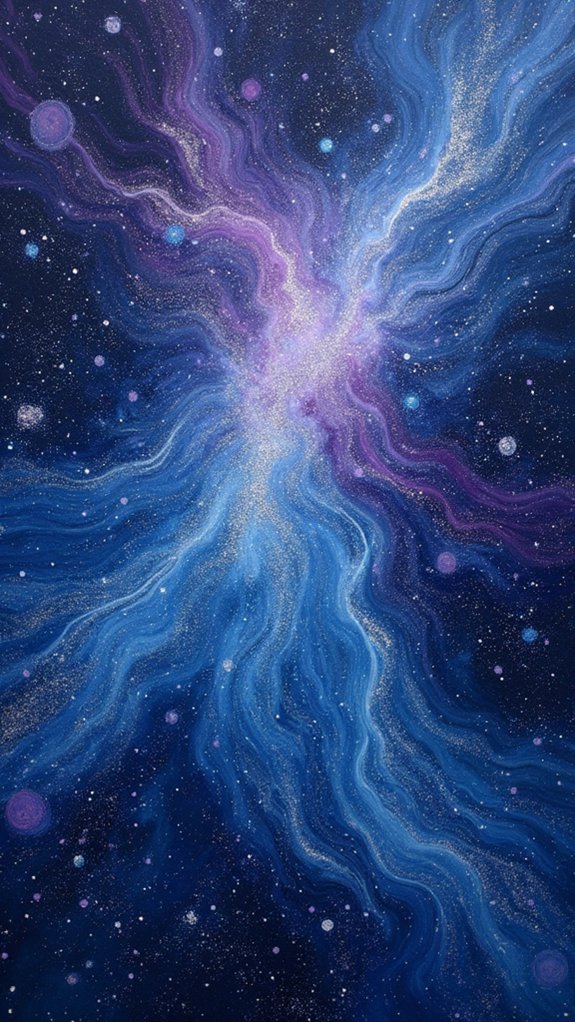
Creating a space and galaxy-themed cover means painting endless star fields that sparkle across a night sky, which is just as awesome as it sounds.
Using a toothbrush or paintbrush for splatter effects, artists can blast bits of color around the page to look like wild nebula clouds—messy hands are basically guaranteed.
With these techniques, anyone’s sketchbook can start to look like it came straight from outer space, minus the zero gravity and aliens.
Painting Celestial Star Fields
Ever wonder how artists turn a boring, blank sketchbook cover into outer space packed with twinkling stars and swirling colors? Here’s one wild idea that’s out of this world—literally!
For anyone seeking inspiration for Sketchbook cover art, painting a celestial star field is a cosmic place to start. First, brush on a black or deep blue base to set that mysterious galaxy vibe.
Then, grab a stiff brush, dip it in white or metallic paint, and flick tiny droplets across the surface—instant stars! Want planetary drama? Blend shades of blue, purple, and pink for glowing nebula effects.
Layering thin washes adds even more depth, making stars look like they’re glowing. Get creative with your splatter tools—try a toothbrush or even your fingers for wild, unexpected patterns!
Splattered Nebula Background Techniques
Blast off into sketchbook customization with splattered nebula backgrounds—a wild, colorful way to make any cover look like it just rocketed in from a galaxy far, far away.
The magic starts with vibrant watercolor paints like deep blue, purple, or pink, blending them together for those classic spacey vibes. Using splattered nebula background techniques, artists grab a toothbrush (yep, really!) or splatter brush to flick thin paint across the cover, creating a universe of random, star-like dots and swirling gas clouds.
Layering different colors after drying adds depth, just like peering into real space. Don’t stop there—metallic or white splatters turn into twinkling stars! A sponge dabbed in lighter hues can highlight certain areas, making it look like galaxies are glowing right out of your sketchbook.
Pastel Ombre Gradient Washes
Although it might look like something only art pros can pull off, pastel ombre gradient washes are actually a super fun way to make any sketchbook cover stand out.
Imagine this: dreamy pinks, soft lavenders, and delicate mint greens fading perfectly into each other like cotton candy clouds. That’s the magic of pastel ombre gradient washes!
The secret sauce is starting with your lightest pastel watercolor, brushing it on one end, then slowly adding darker shades and blending with a wet brush or sponge.
Take your time; patience here means you avoid muddy colors and keep those colors light and breezy. Letting each layer dry before adding the next brings out the best ombre look.
Honestly, experimenting with color combos makes every cover a total masterpiece.
Minimalist Monochrome With Line Art
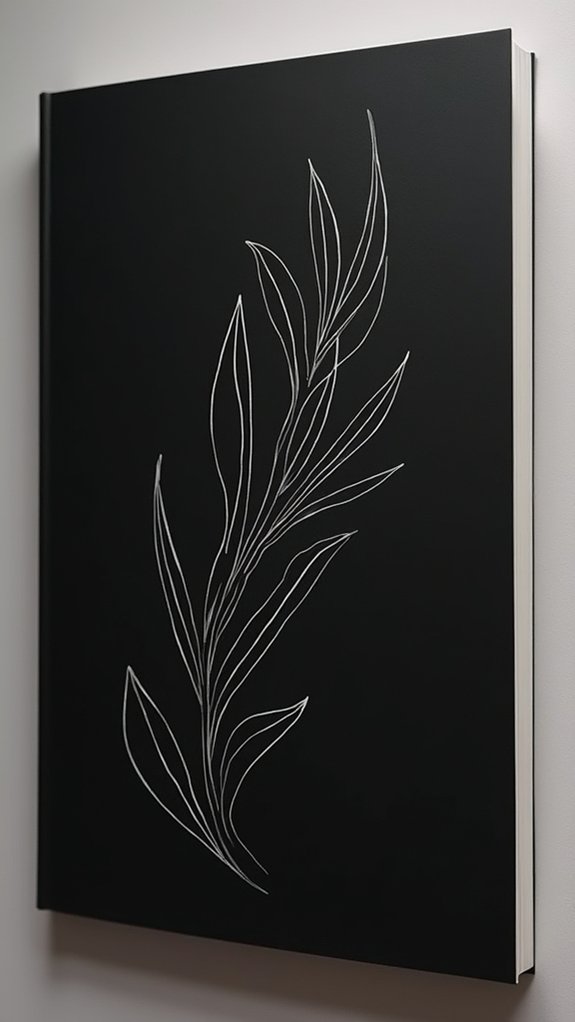
Bold, crisp lines on a black and white sketchbook cover can make a statement before you even open the first page.
With a minimalist monochrome look and strong line art, the design pops without needing any fancy colors—less really is more here.
It’s kind of like your notebook’s showing off its own awesome confidence, turning every glance into a double-take.
Clean Lines, Strong Impact
A sharp black line on a white page can grab attention faster than a neon sign in a blackout. Minimalist monochrome cover designs nail this vibe, using clean lines and a bold, simple color palette—usually just black and white. The big secret? It’s all about precision and knowing when to let space do the talking. Line art takes center stage, creating sketchbook covers that are stylish, detailed, yet never overwhelming. This isn’t just about stick figures or empty spaces—think abstract forms, nature outlines, or cool geometric shapes. Here’s a quick guide to enhance your minimal cover game:
| Element | Impact | Difficulty |
|---|---|---|
| Line Art | Modern & sharp | Easy |
| Negative Space | Bold contrast | Medium |
| Geometric Shapes | Futuristic look | Medium |
| Custom Themes | Totally unique | Varies |
Black and White Aesthetic
When someone wants their sketchbook cover to look seriously cool and still super chill, black and white is the way to go. This style screams sophistication without even raising its voice!
A well-designed black and white aesthetic uses just two colors, but the results can be totally amazing. People love how it feels both modern and classic—like your Sketch Book could belong in an art gallery or on your desk at school.
Want to try it out? Check this out:
- Draw clean line art (think cool flowers, faces, or geometric shapes).
- Play with bold, black-and-white typography for titles or quotes.
- Use negative space so your designs have room to breathe.
- Mix up line thickness and textures for added depth and interest.
Your Sketch Book will be unforgettable!
Botanical Blooms With Bold Brush Strokes
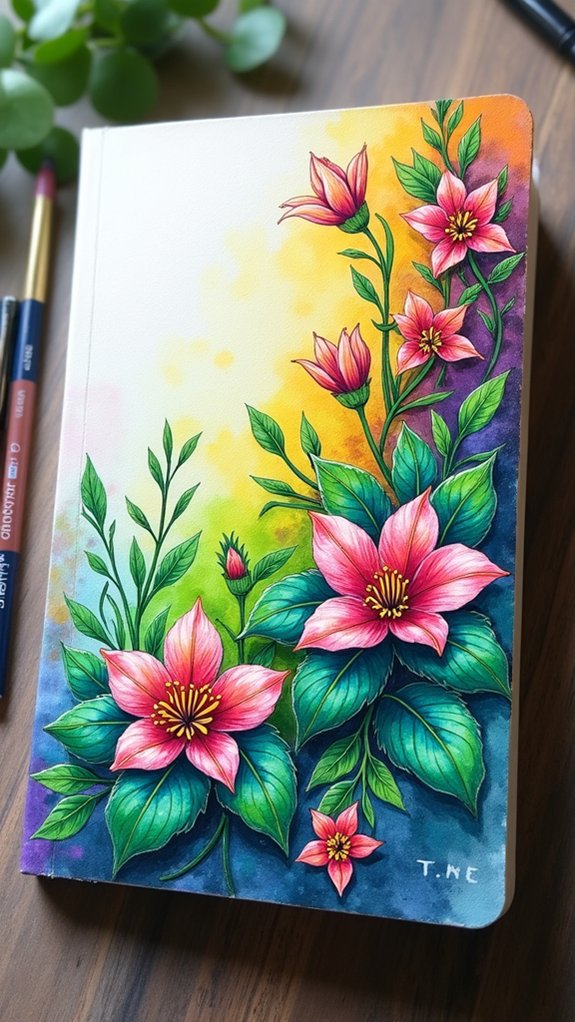
Brilliant blooms practically leap off the page when painted with big, bold brush strokes, turning any sketchbook cover into a real eye-catcher.
Want the best ideas and inspiration for your own cover? Try using vibrant colors—think neon pinks, lush greens, or sunshine yellows. Grab a fat brush and let loose with quick, dramatic strokes. The trick is to experiment!
Mix huge peonies, flashy sunflowers, and even wild tropical leaves for maximum “wow” factor. Switch up stroke directions to bring flowers to life, adding depth and texture with every swish.
Acrylic or watercolor paints are perfect for layering brilliant shades or soft gradients. Pick a color theme—maybe springy pastels or cozy autumn tones—and you’ll have a cover that absolutely pops!
Celestial Bodies: Suns, Moons, and Planets
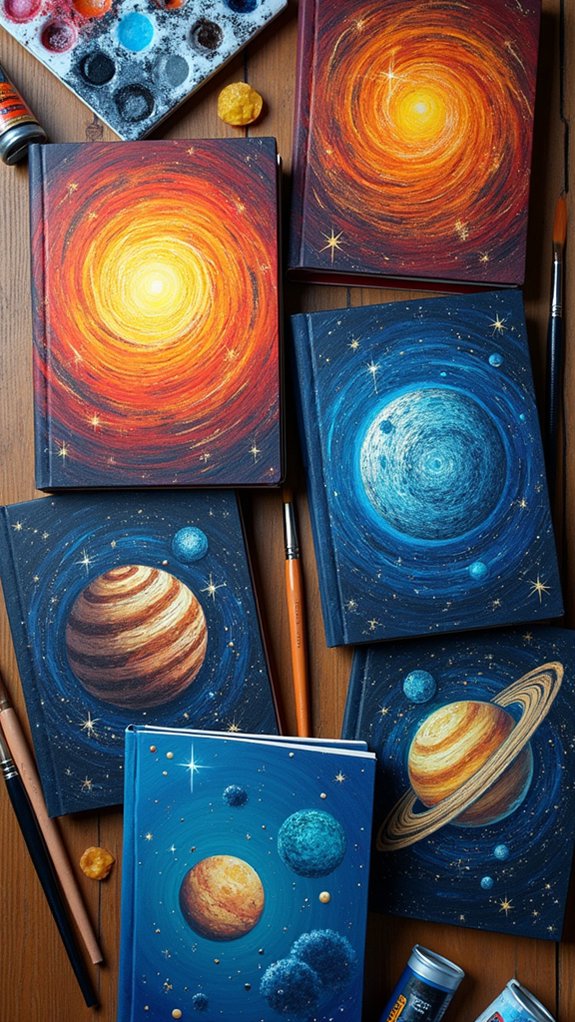
Even before the first pencil ever scratches its pages, a sketchbook with a celestial cover feels like it’s holding secrets from the universe.
Creating a cover featuring suns, moons, and planets isn’t just for astronomy fans—it’s a spark of inspiration for anyone who dreams big.
Picture warm yellows and fiery oranges for glowing suns, cool silver blues for shimmering moons, and deep reds and blues for mysterious planets.
For the most stellar results, try:
- Painting swirling galaxies with watercolor, letting the colors blend softly.
- Using metallic or glow-in-the-dark paints for stars and planet accents—watch your cover come alive in the dark!
- Adding shooting stars or constellation patterns for extra cosmic intrigue.
- Layering planets or moons with acrylics for textured, bold detail.
Suddenly, your sketchbook is pure stardust magic!
Cute Animal Portraits Using Blocking Techniques
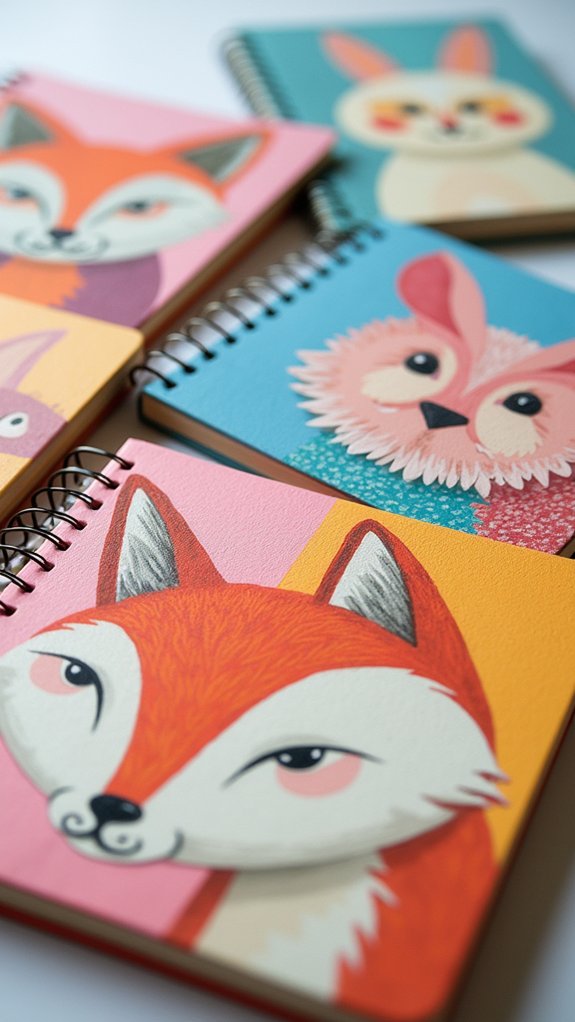
Portraits of adorable animals—now that’s a sketchbook cover destined to make anyone smile! Creating cute animal portraits with blocking techniques is both fun and surprisingly simple.
It all starts with the animal’s silhouette, painted in a neutral tone as the foundation. Then, solid blocks of color take center stage, making each bunny, kitten, or octopus instantly pop off the page. Keeping a limited palette means colors stay bold and easy on the eyes, while contrast helps the animals stand out (because nobody wants a camouflage cat).
With different brush sizes, artists can easily switch from fluffy fur to shiny eyes, adding tons of whimsy and charm. Playful backgrounds—think polka dots or stripes—tie everything together for a sketchbook cover that feels cheerful, modern, and totally unique.
Rainbow Drips and Fluid Color Mixing
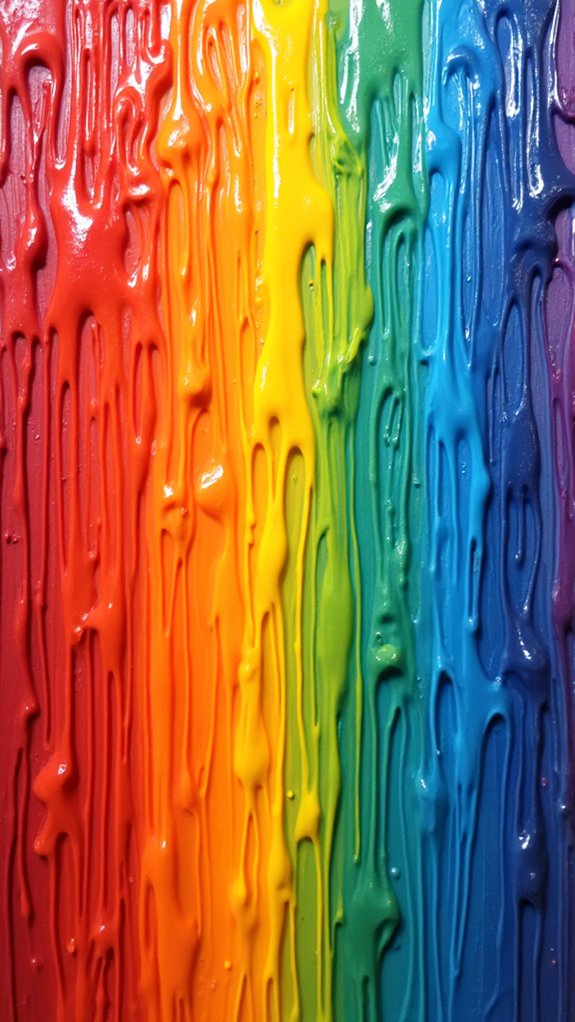
Let wild color take over with the magic of rainbow drips and fluid color mixing—a seriously cool way to turn any sketchbook cover into a piece of art that basically screams “look at me!”
Watching paint flow and blend down the front of a notebook is oddly satisfying, like some kind of messy science experiment you actually want to show off. The wild part? No two covers will ever look the same.
To get that epic rainbow drips vibe and master fluid color mixing, here’s what you need to try:
- Pour or drip bright acrylic paints in stripes or puddles across your notebook’s cover.
- Tilt and tip the sketchbook to watch colors blend and swirl together.
- Add a pouring medium for super-smooth, fluid effects.
- Use a hairdryer or heat gun to create crazy, unpredictable drip patterns!
DIY Fruit People With Playful Colors
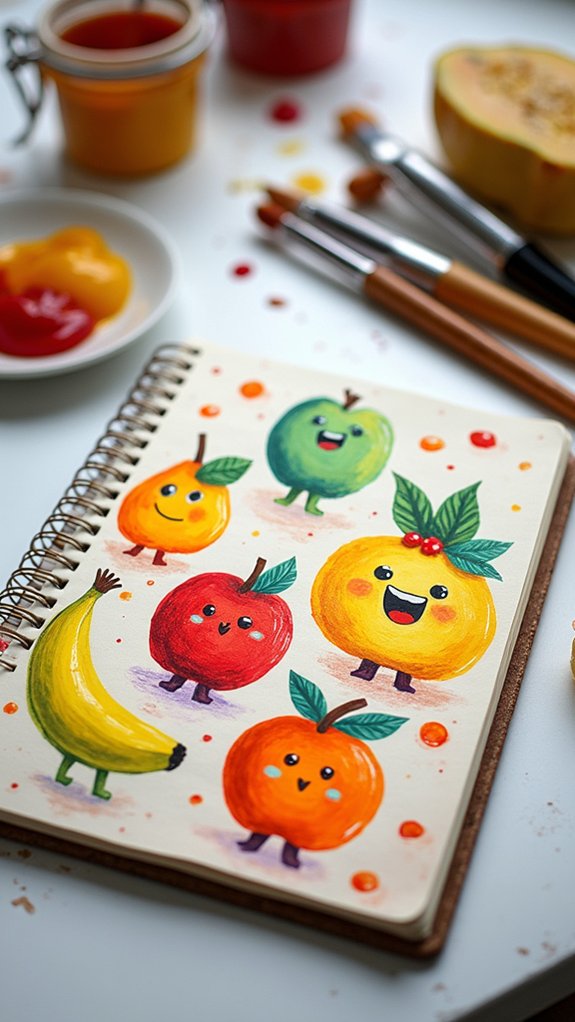
Push aside the boring old fruit bowl—there’s a whole world of quirky fruit people just waiting to jump onto a sketchbook cover!
Imagine a banana in sneakers or a strawberry with a funky hat—why not? Transform regular fruits like kiwis, bananas, and strawberries into wacky human characters by exaggerating their features and letting loose with playful colors.
Make sure to try out wild color combos, like pastels or neon brights, to really make those fruit people stand out. Adding silly accessories or tiny patterned clothes (think orange peel scarves!) gives each character personality.
Use easy poses and goofy expressions to add even more charm. Most important: make sure to have fun and let your mistakes become part of the character’s story!
Urban Street Art-Inspired Layers

Spray cans, stickers, and wild colors—urban street art isn’t just for city walls anymore; it’s perfect for sketchbook covers that practically shout “look at me!”
There’s something exciting about layering stencils, graffiti-style letters, and random splashy patterns until the whole thing feels alive with energy.
Seriously, it’s like all of Pinterest’s best ideas just exploded on your cover! Urban street art-inspired layers aren’t for quiet days—they’re full blast, bold, and 100% fun.
Try these four ideas to get that gritty, vibrant city vibe:
- Stencil bold cityscapes or brick wall textures for ultimate street cred.
- Experiment with neon spray paint or super-bright paint markers.
- Incorporate graffiti-style bubble letters or doodle tags for personality.
- Collage magazine snippets and abstract shapes for extra depth and motion!
Chunky Sticker Collage With Painted Accents
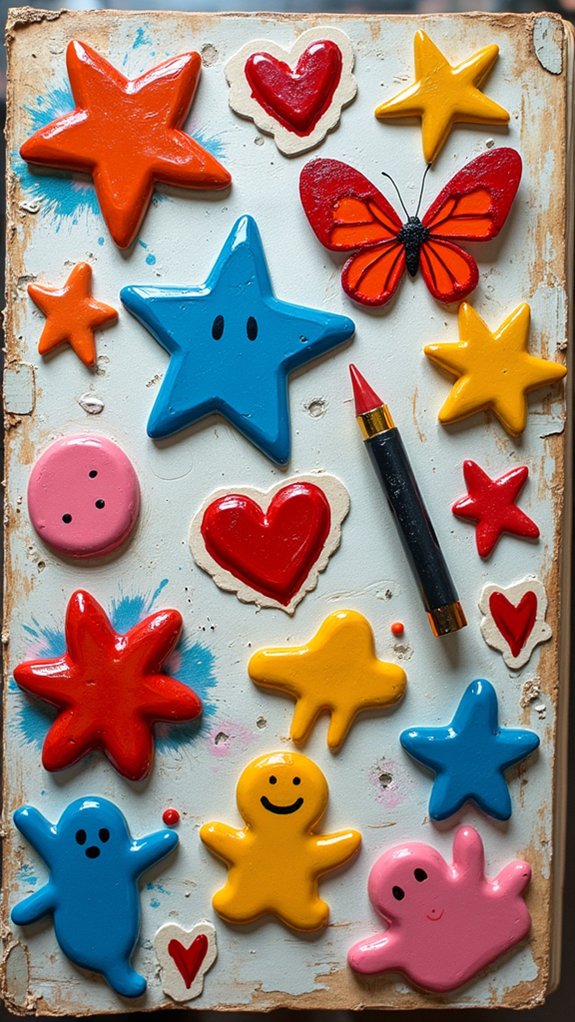
A bunch of bold, chunky stickers can turn a plain sketchbook cover into a total art-fest before you even open the first page.
Seriously, there’s nothing quite like a chunky sticker collage for dialing up the excitement and color. Start by hunting down stickers with big shapes, loud patterns, and tons of personality—think rainbows, wild animals, or funky shapes that fit your style.
Don’t stick them down just yet! Play around with the layout first. When it looks awesome, press the stickers on firmly, but leave some gaps. Those spaces are perfect for painted accents in matching or contrasting colors.
Acrylic or watercolor works great for adding little bursts of color or cool doodles. Finally, slap on a clear coat, and you’re ready to show off!
Black Paper and Metallic Paint Explorations
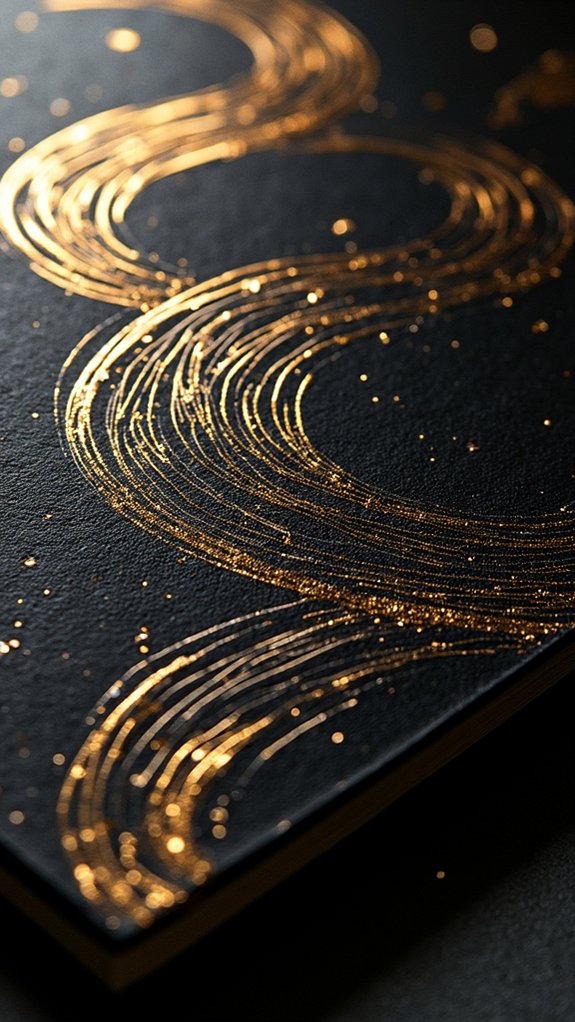
Once all the wild stickers and painted doodles have found their place, there’s another way to totally change up a sketchbook cover—black paper and metallic paint.
Suddenly, your cover can turn from ordinary to eye-popping! The bold contrast makes metallic paint practically glow, and there are so many cool ways to play with this combo.
Check out these tricks to amp up your cover:
- Try different metallic paints like acrylic or watercolor for shiny or shimmery finishes.
- Use techniques like splattering or dry brushing metallic paint for textured effects.
- Layer metallic paint over lighter colors on black paper to make hues even more vivid.
- For really crisp details, go for fine brushes or metallic ink markers to draw neat patterns.
Get ready to wow everyone every time you flip your sketchbook open!
Fan Art Scenes With Simplified Coloring
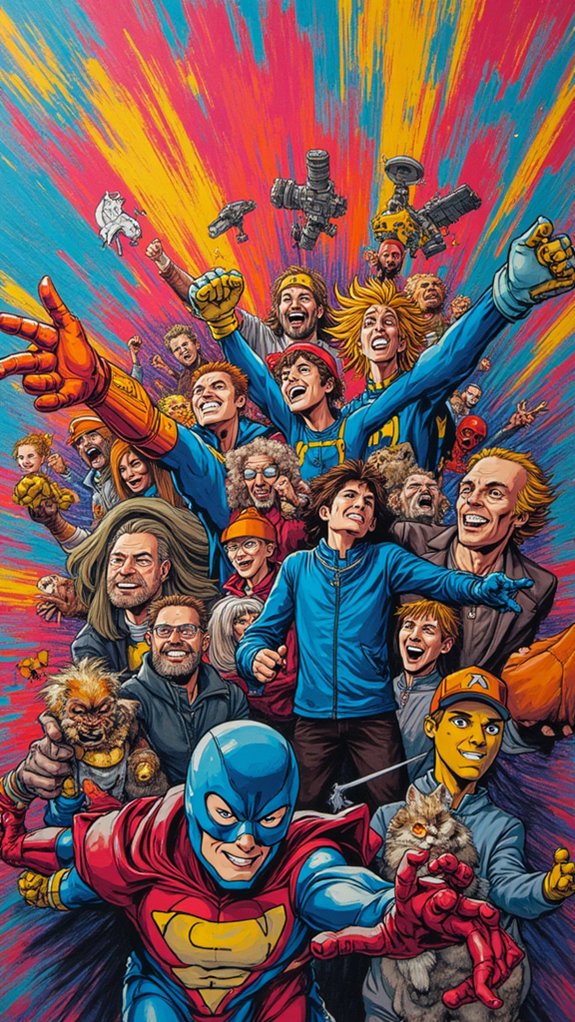
Fan art scenes with simplified coloring let artists pick out those jaw-dropping moments from their favorite shows or games and make them totally their own.
Sticking to a few bold colors keeps things chill and fun—no need to stress about every tiny detail.
Plus, it’s a blast to add little twists to character designs, like a wild new hairstyle or some funky clothes, to show off your own style right on your sketchbook cover.
Choosing Iconic Art Moments
Ever wonder why some moments from movies or shows just stick in your head like glue? That’s the magic of choosing iconic art moments when you want to create something meaningful for your sketchbook cover.
Picking a legendary scene for fan art isn’t only about loving the character; it’s about grabbing that instant everyone knows and putting your stamp on it. You don’t need every detail to make it shine!
Try these steps:
- Watch your favorite scene and pause on the best moment.
- Find simple but strong poses or gestures.
- Use reference images for accuracy (even the goofy ones).
- Focus on bold colors, ignoring tiny details.
Minimalist Color Palette Tips
There’s something seriously cool about seeing a famous scene reimagined with just a handful of colors.
Minimalist color palette tips can make your fan art scenes pop—even if you’re only using two to four colors. Choosing flat colors over fancy shading gives everything a clean, bold vibe, keeping things simple but super stylish.
Try picking complementary colors to make sure the background and characters look awesome together and your main subject really stands out. If you like a little magic, play around with opacity and layering for a bit of depth, but don’t overdo it—less is more!
Use negative space like a pro so your main image grabs attention, and the whole thing looks neat instead of crowded. Minimalism, activated!
Personalizing Character Designs
How cool is it when someone takes a familiar character and puts their own creative twist on it? That’s exactly what happens when artists start personalizing character designs—suddenly, fan art scenes feel new, wild, and totally THEM.
Simplified coloring helps the process by letting the artist focus more on the big, bold choices instead of sweating tiny details. Here are four tips to keep things fun and easy:
- Use reference images for accuracy, then switch up the colors for extra flair.
- Play with simplified shapes and lines—don’t stress perfection!
- Test out wild or “impossible” color palettes for a unique vibe.
- Sneak in playful touches, like funky accessories or silly facial expressions, so your fan art stands out.
Personalizing character designs means every sketchbook cover is one-of-a-kind!
Doodle Flower Fields With Watercolor Backgrounds
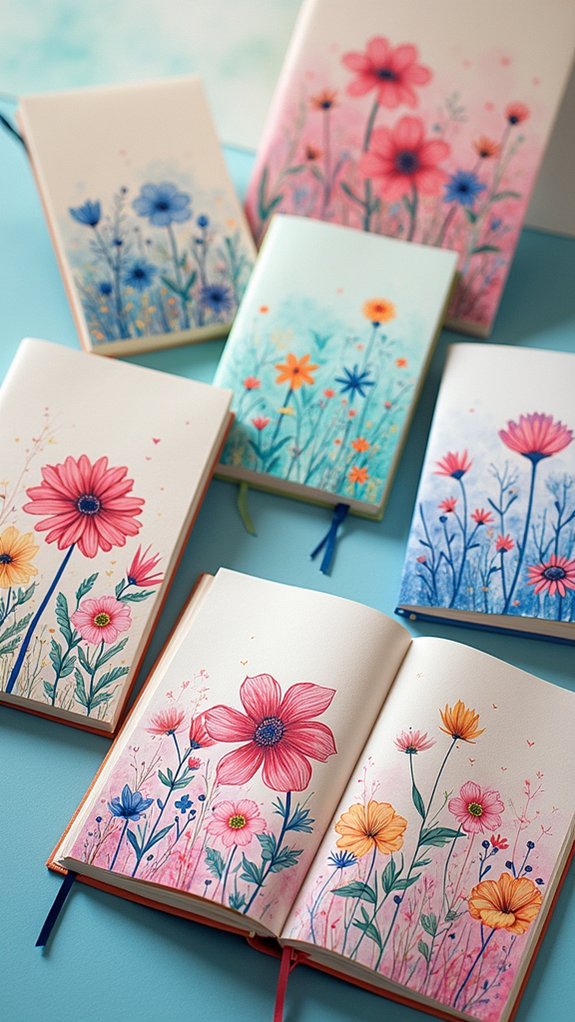
Although a plain sketchbook cover can be just fine, turning it into a field of doodle flowers with a splashy watercolor background brings a whole new level of fun. Imagine sketching out random flowers—big, small, weird shapes—all across your cover. Next, get messy with watercolors, mixing dreamy pinks, purples, and yellows into the background until it feels like a magical garden party. Try different painting tricks for extra texture and depth. Want to boost the vibe even more? Grab a fine liner and add curly stems or playful leaves.
| Step | Artistic Tip |
|---|---|
| Pencil the flowers | Let them flow and overlap for a natural look |
| Watercolor magic | Blend colors for a soft, dreamy effect |
| Fun finishing touch | Splatter paint or ink for energy and movement |
Who knew doodle flower fields could look this cool?
Frequently Asked Questions
What Can You Decorate Your Sketchbook With?
One can decorate a sketchbook cover with various art supplies, including watercolor paints, markers, stickers, washi tape, and cut-out images. Additional options include adding doodles, illustrations, geometric patterns, or inspirational quotes for a personalized touch.
What Paint to Use on Sketchbook?
Paint selection for sketchbook covers depends on desired effects and surface material. Acrylic paint offers vibrant, durable coverage, while watercolor provides softer blends. Fabric paint suits canvas covers. Ensuring archival-quality paint helps prevent fading and preserves artwork longevity.
How Do You Decorate the Front Cover of a Sketchbook?
When exploring Cover Inspiration, one might combine watercolor or acrylic painting with mixed media elements like stickers or fabric. Unique color schemes, nature or abstract motifs, and playful doodles can each creatively enhance a sketchbook’s front cover.
How to Start a Daily Sketchbook?
Establishing a daily sketchbook routine involves setting a consistent time and accessible location, selecting new themes for daily inspiration, starting with warm-up sketches, and tracking progress, which collectively enhances creativity and sustains long-term artistic growth.
Conclusion
With so many cool sketchbook cover ideas, it’s honestly tough to pick just one. Some are wild and colorful, others are chill and simple, but all of them help show off your personality. Whether you go full-on galaxy mode or just doodle a bunch of flowers, it’s your sketchbook—make it awesome! Grab your paints, get a little messy, and see what happens. Who knows? Your cover might just be your new favorite art project.

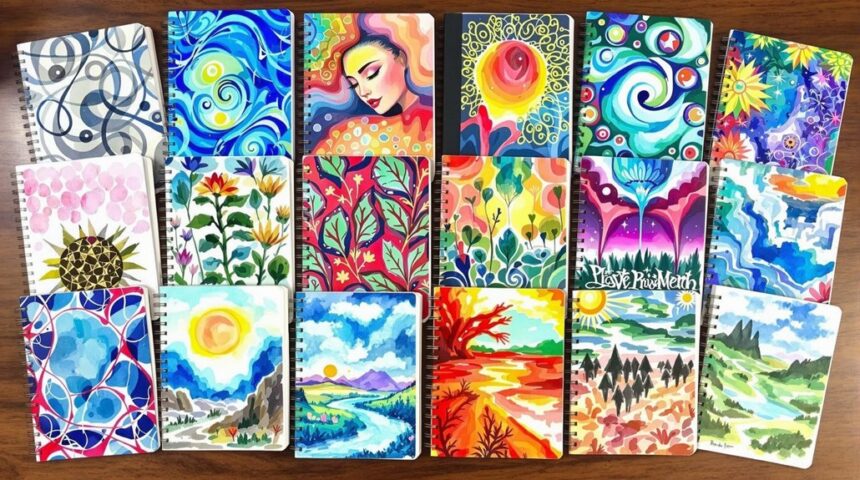
Leave a Reply